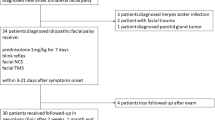Abstract
Objective
Electroneurography (ENoG) reliably predicts the prognosis of facial palsy. However, the results of ENoG are dependent on the location, where the wave is detected, as a compound muscle action potential (CMAP) arising from the facial muscles. To minimize errors in prognostic prediction, we analysed the latencies of facial CMAPs.
Materials and methods
Fifty-seven patients with unilateral peripheral facial palsy and 24 healthy volunteers were enrolled. Amplitudes, negative peak latencies (NPL), and rise latencies (RL) of CMAPs were measured on the paralysed and healthy sides in patients and in healthy volunteers. The relationships of these latencies with ENoG values and the lowest House–Brackmann (H–B) scores were also analysed.
Results
The amplitude of CMAP on the paralysed side was smaller, and NPL and RL were longer, than those on the healthy side in patients and healthy volunteers (p < 0.01). In patients, there was no difference in NPL between the ENoG < 40% group and the ENoG ≥ 40% group. Conversely, there was a significant difference in RL between the ENoG < 40% group and ENoG ≥ 40% group (p = 0.03). No relationships were observed between NPL or RL and the lowest H–B score.
Conclusions
NPL and RL of CMAP on the paralysed side were equivalent or longer than those on the healthy side. During ENoG for facial palsy, CMAP should be measured on the healthy side first, and then detected (and the amplitude measured) on the paralysed side with reference to CMAP latency on the healthy side, to reduce errors in detecting facial CMAPs.





Similar content being viewed by others
References
Esslen E (1973) Electrodiagnosis of facial palsy. In: Miehlke A (ed) Surgery of the facial nerve. WB Saunders, Philadelphia, pp 45–51
Fisch U (1980) Maximal nerve excitability testing vs. electroneuronography. Arch Otolaryngol 106:352–357
Gantz BJ, Gmuer AA, Holliday M, Fisch U (1984) Electroneurographic evaluation of the facial nerve method and technical problems. Ann Otol Rhinol Laryngol 93:394–398
Smith IM, Murray JA, Prescott RJ, Barr-Hamilton R (1988) Facial electroneurography: standardization of electrode position. Arch Otolaryngol Head Neck Surg 114:322–325
Haginomori S, Wada S, Takamaki A, Nonaka R, Takenaka H, Takubo T (2008) A new method for measuring compound muscle action potentials in facial palsy: a preliminary study. Muscle Nerve 37:764–769
Haginomori S, Wada S, Takamaki A et al (2010) A novel electroneurography method in facial palsy. Acta Otolaryngol 130:520–524
House JW, Brackmann DE (1985) Facial nerve grading system. Otolaryngol Head Neck Surg 93:146–147
Seddon HJ (1943) Three types of nerve injuries. Brain 66:237–288
Celik M, Forta H, Vural C (2000) The development of synkinesis after facial nerve paralysis. Eur Neurol 43:147–151
Kanaya K, Ushio M, Kondo K et al (2009) Recovery of facial movement and facial synkinesis in Bell's palsy patients. Otol Neurotol 30:640–644
Tojima H (1988) Measurement of facial nerve conduction velocity and its application to patients with Bell’s palsy. Acta Otolaryngol Suppl 446:36–41
Aoyagi M, Saito O, Tojima H, Maeyama H, Koike Y (1994) Distribution of facial nerve conduction velocities in patients with Bell’s palsy. Eur Arch Otorhinolaryngol (Suppl) S514-S516
Coker NJ, Salzer TA (1990) The use of masseter electromyography with electroneurography in the evaluation of facial paralysis. Otolaryngol Head Neck Surg 103:391–395
Acknowledgements
This work was partially supported by the Japan Society for the Promotion of Science Grant (JSPS KAKENHI Grant Nos. #16K11201 and #19K09919).
Author information
Authors and Affiliations
Corresponding author
Ethics declarations
Conflict of interest
The present authors have no financial relationship to disclose.
Ethical approval
Approval for this study was obtained from the Institutional Ethical Review Board of Osaka Medical College (Approval #0484 and RIN375).
Informed consent
Informed consent was obtained from all individual participants (patients and volunteers) included in the study.
Additional information
Publisher's Note
Springer Nature remains neutral with regard to jurisdictional claims in published maps and institutional affiliations.
Rights and permissions
About this article
Cite this article
Ayani, Y., Haginomori, SI., Wada, SI. et al. Latency shift in compound muscle action potentials during electroneurography in facial palsy. Eur Arch Otorhinolaryngol 276, 3281–3286 (2019). https://doi.org/10.1007/s00405-019-05634-y
Received:
Accepted:
Published:
Issue Date:
DOI: https://doi.org/10.1007/s00405-019-05634-y




